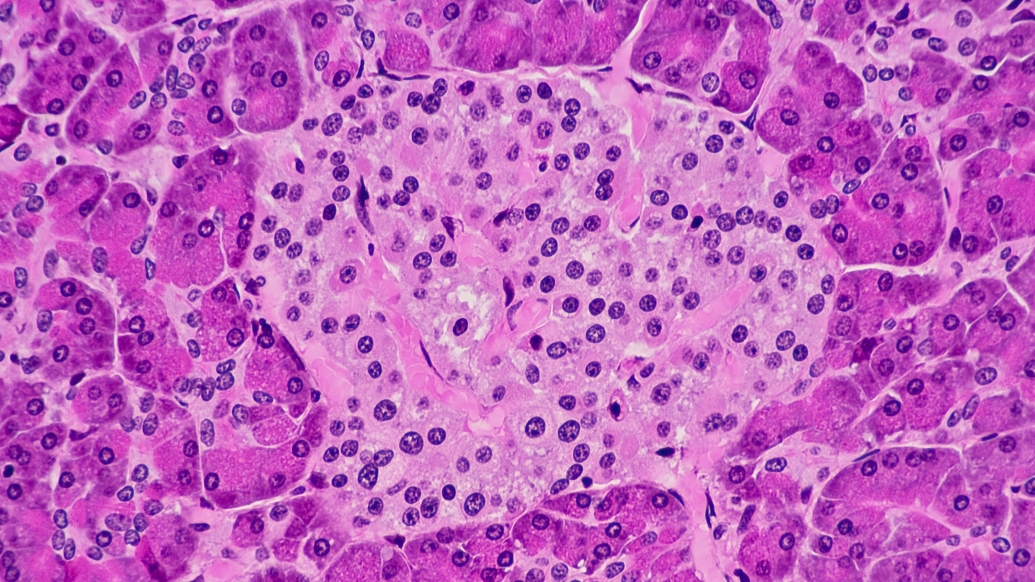The findings lay the foundation for identifying additional early disease-driving indicators and provides a pathway for finding regulatory networks that drive other diseases
11:00 AM
Authors |

Sign up for Health Lab newsletters today. Get medical tips from top experts and learn about new scientific discoveries every week by subscribing to Health Lab’s two newsletters, Health & Wellness and Research & Innovation.
Sign up for the Health Lab Podcast: Add us on Spotify, Apple Podcasts or wherever you get you listen to your favorite shows.
In a collaborative effort co-led by teams from Vanderbilt University Medical Center and the University of Michigan, a comprehensive study that integrates multiple analytic approaches has linked a regulatory gene network and functional defects in insulin-producing pancreatic beta cells to type 2 diabetes.
The study, published in the journal Nature lays the foundation for identifying additional early disease-driving events for type 2 diabetes and also provides a template for identifying regulatory networks that drive other diseases.
Type 2 diabetes affects almost 35 million people in the United States, increasing the risk of death and causing serious health complications including blindness, kidney failure, heart disease and stroke, according to the Centers for Disease Control and Prevention.
Genome-wide association studies have linked hundreds of sites in the genome to increased risk of Type 2 diabetes, but more than 90% of the sites are located in non-coding rather than protein-coding regions of DNA.
“How this genetic variation at the population level relates to molecular changes in gene expression, tissue architecture and cellular physiology in Type 2 diabetes is not well understood. By generating comprehensive functional, transcriptomic, and spatially resolved multiplex imaging datasets, we identified key signatures of islet dysfunction,” said Marcela Brissova, Ph.D., research professor of Medicine at VUMC and a co-lead on the paper.
The study is the result of interdisciplinary teamwork across VUMC and the University of Michigan, including co-first authors Jack Walker, M.D., Ph.D., and Diane Saunders, Ph.D., at VUMC and Vivek Rai, Ph.D., at the University of Michigan.
Although processes that contribute to type 2 diabetes have been studied in rodent models, human islets — the mini-organs that house beta cells along with a number of other cell types — differ from rodent islets in multiple ways.
“There is a need for studies to define the mechanisms that initiate and sustain islet dysfunction in primary human islets, which is where we focused our efforts,” said Alvin C. Powers, M.D., director of the Vanderbilt Diabetes Research and Training Center, Joe C. Davis Professor of Biomedical Science and a co-lead of the study.
The cross-institutional, collaborative effort used a multimodal approach to study pancreas and islets from donors with early-stage type 2 diabetes and controls.
This allowed for the integration of the islet function ex vivo and in vivo (in a mouse model) with comprehensive transcriptional (gene expression) analysis using RNA-sequencing, and islet cellular architecture assessed by multiplex imaging.
Working with co-lead author Stephen C. J. Parker, Ph.D., associate professor of Computational Medicine & Bioinformatics, Human Genetics and Biostatistics at the University of Michigan, the interdisciplinary team connected laboratory findings from single cells to population-scale genetics, looking for differences in gene expression between people with early-onset type 2 diabetes and normal controls.
“With this multimodal approach, we used integrative data analytic methods to build gene networks and connect them to Type 2 diabetes genome-wide association studies signals and islet physiology.
“All data are publicly available through user-friendly and interactive web portals. We hope these data will generate many hypotheses that will be pursued in the near future,” said Parker.
Within one network, they discovered that the transcription factor RFX6 had an outsized influence within beta cells, serving as a hub within this gene network, and that it was reduced in beta cells from individuals with type 2 diabetes.
In further studies of RFX6 and its regulatory network, the researchers used an in vitro human pseudoislet model and single-nucleus multi-omics profiling to show that disruption of RFX6 in beta cells led to reduced insulin secretion and altered chromatin architecture at regions enriched for type 2 diabetes genome-wide association studies signals.
Using phenotype and genotype data from the UK Biobank across nearly one-half million people of European ancestry, they found that predicted decreased islet expression of RFX6 was causally associated with type 2 diabetes.
This type of prediction, the team notes, could potentially be replicated in other diseases for which there’s genome-wide association studies data.
“Precisely what underlies the initial RFX6 dysregulation and whether it can be targeted to prevent or reverse early-stage molecular and functional defects in the beta cell will be important areas of further investigation,” said Brissova.
Additional authors include Hung-Hsin Chen, Chunhua Dai, Alexander Hopkirk, Conrad Reihsmann, Shristi Shrestha, Lauren Petty, Jordan Wright, Radhika Aramandla, Greg Poffenberger, Regina Jenkins, Shaojun Mei, Nathaniel Hart, Sharon Phillips, Hakmook Kang and Jennifer Below, all from VUMC; Yasminye Pettway from Vanderbilt University; Peter Orchard, Yicheng Tao, Simin Fan, Arushi Varshney, Christa Ventresca, Samir Agarwala and Jie Liu, all from University of Michigan; Dale Greiner from University of Massachusetts Medical School; Leonard Shultz from The Jackson Laboratory; and Rita Bottino from Imagine Pharma.
The research was supported by grants from the National Institutes of Health (DK106755, DK123716, DK123743, DK120456, DK104211, DK108120, DK104218, DK112232, DK112217, DK117960, DK126185, DK117147, HL142302, DK127084, HL163262, DK129469, DK135017, EY032442, T32GM007347, F30DK118830, and P30DK020593 supporting the Vanderbilt Diabetes Research and Training Center), The Leona M. and Harry B. Helmsley Charitable Trust, JDRF, Doris Duke Charitable Foundation, and the Department of Veterans Affairs (BX000666).
Brissova, Saunders and Powers are members of the National Institute of Diabetes and Digestive and Kidney Diseases (NIDDK)-supported Human Pancreas Analysis Program (HPAP) within the Human Islet Research Network (HIRN). Parker is a member of the NIDDK-sponsored Accelerating Medicines Partnership® Program for Common Metabolic Diseases (AMP-CMD).
Paper cited: “Genetic risk converges on regulatory networks mediating early type 2 diabetes,” Nature. DOI: 10.1038/s41586-023-06693-2

Explore a variety of healthcare news & stories by visiting the Health Lab home page for more articles.

Department of Communication at Michigan Medicine
Want top health & research news weekly? Sign up for Health Lab’s newsletters today!





